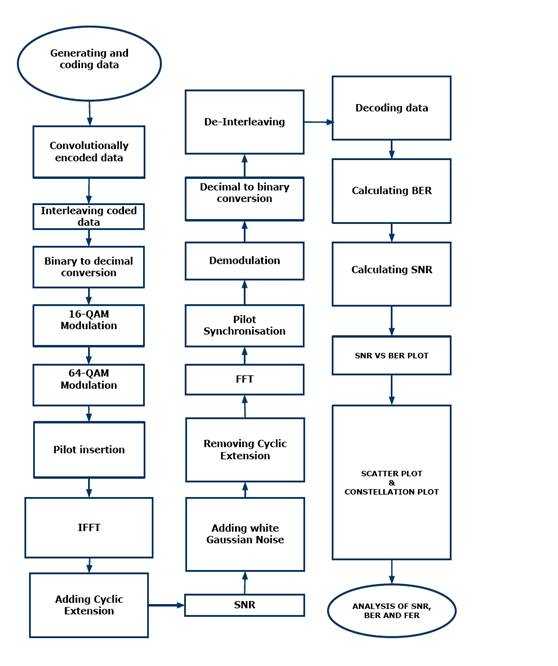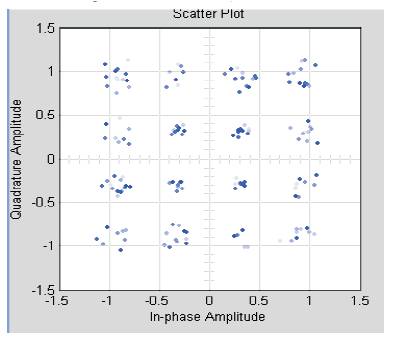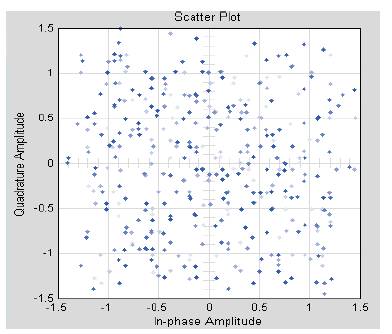Frame Error Rate Performance for Adaptive M-QAM/ S-OFDM Based Wireless Systems
A. Raja * V. Thulasibai **
* Research Scholar, Sathyabama University, Chennai, India
** Professor and Dean, Department of ECE, Prathyusha Institute of Technology and Management, Chennai, India
Abstract
OFDM is a high data rate transmission modulation scheme which has complexity in wireless channels and can be merged with scalability for improving reliability of system called S- OFDM. In this paper, the authors have proposed a performance analysis of Frame Error Rate (FER) for hybrid S-OFDM system in Rayleigh channel. The proposed scheme is shown to achieve lower Bit Error Rate (BER) and capturing more efficient receiver of multipath energy, selecting a fraction of subcarriers with conjugate symmetric inputs to achieve the spreading. A channel SNR versus BER for both time and frequency for a 512-subcarrier OFDM with single-transmitter and single-receiver systems over an indoor wireless channel. The performance is evaluated for an S-OFDM system based on the IEEE 802.11. Simulation results show that, the proposed scheme can achieve low BER and FER for a QAM- S-OFDM Symbols. The average channel SNR is 10 dB. The 16- QAM and 64-QAM are used in cable modem and many wireless technology applications.
Keywords :
- Orthogonal Frequency Division Multiplexing (OFDM),
- Scalable Orthogonal Frequency Division Multiplexing (SOFDM),
- Quadrature Amplitude Modulation (QAM),
- Signal to Noise Ratio (SNR),
- Frame Error Rate (FER),
- Bit Error Rate (BER).
Introduction
Orthogonal Frequency Division Multiplexing (OFDM) is a modulation Technique for transmitting large data Over Radio waves. This technique is used for frequency selective fading caused by multi-path fading channel. The illustration for four subcarriers within one OFDM symbol is shown in Figure 3. Figure 4 shows the spectrum of indivual subcarriers. The wireless communication has entered into its Fourth Generation (4G). An OFDM signal consists of a sum of sub-carriers, each of which contains M-ary Phase Shift Keyed (PSK) or Quadrature Amplitude Modulated (QAM) signals. Modulation types over OFDM systems Phase Shift Keying (PSK) Quadrature Amplitude Modulation (QAM).One of the main differences between wireless cellular and wired networks is the inherent mobility of the terminals. Orthogonal Frequency Division Multiplexing (OFDM) is a multicarrier transmission technique, which divides the available spectrum into many carriers, each one being modulated by a low rate data stream. OFDM is similar to FDMA in that the multiple user access is achieved by subdividing the available bandwidth into multiple channels, which are then allocated to users. However, OFDM uses the spectrum much more efficiently by spacing the channels much closer together. This is achieved by making all the carriers orthogonal to one another, preventing Interference between the closely spaced carriers. Figure 1 shows the cooperative communication system of OFDM. It achieves the minimum overall transmit power while not violating the constraints on user's data rate [1-2]. Many algorithms have been proposed for solving OFDMA downlink resource allocation problems [3-5]. Adaptive OFDM modems channels can ease the problem of slowly time varying channels, since the variation of the signal quality can be exploited in both time and frequency domain. The channel conditions still have to be monitored based on the received OFDM symbols, and relatively slowly varying channels have to be assumed, that OFDM transmissions are not well suited to rapidly varying channel conditions. In [8] and [9], 16- QAM modulation in an OFDM system has been investigated. A decision-directed channel tracking method, which allows the use of multiamplitude schemes in a slow Rayleigh-fading environment is analysed in [8]. In this, given single carrier adaptive system in narrowband channels will therefore operate efficiently only in a limited range of channel conditions. [7].

Figure 1. OFDM cooperative communication system
1. Scalable Orthogonal Frequency Division Multiplexing (S-OFDM)
Scalable OFDMA is a key technology behind mobile WiMAX and is widely regarded as an enabling technology for future broadband wireless protocols, including the 3GPP and 3GPP2 long-term evolution standards. Figure 2 shows the Scalable-OFDM SYSTEM. The key technique is to dynamically scale the baseband processing itself to the user requirement, the environment, the platform, etc. In this paper, the authors present the scalable design and VLIW processor based implementation of the OFDMA modulator, which is one of the most energy consuming parts of OFDMA and MIMO- OFDMA transmitters (in IEEE 802.16e ,3GPP LTE, etc.).It enables the OFDMA modulator to scale the modulation- accuracy and computationload, so that the OFDMA modulator can dynamically reconfigure and work with minimal number of operations, whereas the required modulation-accuracy is still firmly guaranteed. This implementation gives reductions in the average load and energy dissipation on real-time programmable platform. [10] The predicted unprotected BER was discredited into intervals of 1%, and the channel coded FER was evaluated over these BER intervals. For estimated protected BER values below 5%, no frame errors were observed for any of the modes. For higher estimated unprotected BER values, the higher throughput modes exhibited a lower FER than the lower throughput modes, which was consistent with the turbo coder's performance. Which increase for longer block lengths, a FER of 1% was observed for a 7% predicted unprotected error rate for the 10 kbps mode, while BER values of 8% to 9% were allowed for the longer blocks, whilst still maintaining a FER of less than 1%[7]. Our 4-bit example results in a 16-QAM signal “constellation” of 16 symbols (16= 24), forming a 16-point grid when viewed on a modulation analyzer. Typical digital transmission systems use a 16-QAM, 32-QAM or 64-QAM constellation, depending on the required transmission bit rate and the desired C/N at a serviced receiver. Table 1 shows the specifications for IEEE 802.16a.

Figure 2. Scalable-OFDM System

Table 1. Bit Rates of QAM and PSK
2. Single-carrier QAM for OFDM
Multiple access schemes are used to allow many simultaneous users to use the same fixed bandwidth radio spectrum. In any radio system, the bandwidth that is allocated to it is always limited. For mobile phone systems, the total bandwidth is typically 50 MHz, which is split in half to provide the forward and reverse links of the system. Sharing of the spectrum is required in order to increase the user capacity of any wireless network. To generate the OFDM successfully, the relationship between all the carriers must be carefully controlled to maintain the orthogonality of the carriers. The various properties of QAM may be used when data-rates beyond those offered by 8-PSK are required by a radio communications system. This is because QAM achieves a greater distance between adjacent points, in the I-Q plane by distributing the points more evenly. Figure 5 shows the Constellation pattern for 64-QAM, and in this way, the points on the constellation are more distinct and data errors are reduced. Table 1 shows the bit rates of QAM and the PSK. Each carrier to be produced is assigned some data to transmit. The required amplitude and phase of the carrier is calculated based upon the modulation scheme.
The required spectrum is then converted back to its time domain signal using an Inverse Fourier Transform. In most applications, an Inverse Fast Fourier Transform (IFFT) is used. The IFFT performs the transformation very efficiently, and provides a simple way of ensuring that the carrier signals produced are orthogonal. Rayleigh fading channels with exponential power profile are considered. The maximum transmitted power of each user is 0.1W, the maximum Doppler frequency shift is 90Hz, and total bandwidth is 1MHz. N=128 and user number varies from 2 to 16. The average sub channel SNR is 35dB with BER ≤ 10−4. The channel information is assumed to be sampled every 0.5ms for updating the subcarrier allocation. [6].
3. Fast Fourier Transform for OFDM
The Fourier transform sub-divides the signal into many frequency bits by taking product of the signal with a series of sinusoidal signals. This translates the signal from time domain to frequency domain. But IFFT is always the conversion technique followed to convert from frequency domain to time domain. This algorithm implements the discrete Fourier transform to transform data from time into the frequency domain. To remove this high frequency noise, multiply their Fast Fourier Transform transforms element-wise and apply the inverse FFT on the waveform, and amplitude spectrum of a signal. Sampling range of the signal sampling rate end at the range samples of the signal, over the range Filtering Noise from Signals.
For example, IEEE 802.11 standard [11] specifies the following parameters for its OFDM physical layer.
FFT/IFFT size = 64 (implies 64 subcarriers in total = used + unused = Nfft)
Number of data subcarriers = 48
Number of pilot subcarriers = 4
Derived parameters from the above specification.
Number of total USED subcarriers = 52 (48+ 4)
Number of total UNUSED subcarriers = 12 (64 – 52).
As per the standard specifications, these 52 used subcarriers are distributed in the following way. 52 used subcarriers are named as 1, 2, 3… 26 and -1,-2,-3,…,-26. The used subcarriers 1 to 26 are mapped to 1 to 26 of IFFT inputs and the subcarriers -1,-2,..,-26 are mapped to the IFFT inputs 38 to 63. The remaining IFFT inputs 27 to 37 and the input 0 (dc input) are set to 0. In this procedure, the 12 null subcarriers are mapped to IFFT inputs and the mapped subcarriers can be used for the constellation pattern. Figures 3 and 4 show the Illustration of four subcarriers within one OFDM symbol and Spectral representation for individual subcarriers

Figure 3. Illustration of Four subcarriers within one OFDM symbol

Figure 4. Spectral representation for individual subcarriers

Figure 5. Constellation Pattern for 64-QAM
4. Simulation Results
4.1 Simulation Process
- Modulating data
- Serial to Parallel conversion
- Pilot Insertion
- Subcarrier Generation
- Inverse Discrete Fourier Transforms (IDFT)
- Cyclic Prefix for OFDM Signal
- Beam former
- Cyclic Prefix Removal
- Circular Convolution Reversal
- BER results& FER Performance
- Constellation Output for 64-QAM
figure 6 shows the Flowchart for OFDM simulation process. The simulation results shown below are SNR vs. BER in various parameters, Beam forming, Constellation and frame error rate performance. Figure 9 shows FER throughput performance of the 16 sub band 512 subcarrier switching level adaptive OFDM modem employing BPSK, QPSK, 16- QAM and no transmission over the Rayleigh fading time dispersive channel. Figures 7 & 8 show the simulation results for bit error rate vs. signal to noise ratio in dB for a QAM-SOFDM system. Figures 10 & 11 show the constellation plot for 16-QAM & 64-QAM

Figure 6. Flowchart Showing the Simulation Process for OFDM

Figure 7. BER vs. SNR in dB

Figure 8. BER vs. SNR in dB

Figure 9. Frame error rate performance

Figure 10. Constellation Plot of 16- QAM

Figure 11. Constellation Plot of 64- QAM
Conclusion
In all of the simulations, the authors have set N =16&64 QAM. 10 OFDM symbols per transmission frame were used. A bandwidth of 20 MHz was employed. The modulation level is 64-QAM and constellation is shown. Figure 10 shows the Constellation plot for 64-QAM. But there is a problem of BER (Bit Error Rate) which increases as the order of the modulation increases. Simulation results show that the proposed scheme can achieve low BER and FER for a QAM- S-OFDM Symbols. This average channel SNR is 10 dB and the 64-QAM is used in cable modem and many wireless technology applications. The solution to this problem is to increase the value of the SNR, so that the effect of the distortions introduced by the channel will also get reduced as a result of this. The FER and BER will also decrease at higher values of the SNR for high order modulations considering the advantages in scalability, throughput, and fairness. This scheme can be utilized by current HYBRID OFDMA network standards, such as the IEEE 802.16, so that spectrum efficiency and flexibility can be further improved.
References
[1]. Cheong Yui Wong, Roger S. Cheng, Khaled Ben Letaief, and Ross D. Murch, (1999). “Multiuser OFDM with Adaptive Subcarrier, Bit, and Power Allocation,” IEEE Journal on selected areas in communications, Vol. 17, No. 10.
[2]. Khalid El Baamrani, Abdellah Ait Ouahman, Victor P. Gil Jim ´Enez, Ana Garcia Armada and Said Allaki, (2006). “Subcarrier and Power Allocation for the Downlink of Multiuser OFDM Transmission,” Wireless Personal Communications, 39:(4) 457–465. www.researchegate.net.
[3]. C. Y. Wong, R. S. Cheng, K. B. Letaief, and R. D. Murch, (1999). “Multiuser OFDM system with adaptive subcarrier, bit, and power allocation,”IEEE J.Select. Areas Commun, Vol. 17, pp. 1747-1758.
[4]. Z. Shen, J. G. Andrews, B. L. Evans, (2005). “Adaptive resource allocation in multiuser OFDM systems with proportional rate constraints,” IEEE Trans. wireless commun, Vol. 4, pp. 2726-2737.
[5]. J. Hui, and Y. Zhou, “Enhanced rate adaptive resource allocation scheme in downlink OFDMA system,” in Proc. IEEE VTC 2006-Spring, Vol. 5, pp. 2464-2468.
[6]. Bin Da and C.C.Ko, “Dynamic Subcarrier Sharing Algorithms for Uplink OFDMA Resource Allocation,” in Proc.IEEE ICICS, 2007, Vol.1, pp.0983-7.
[7]. L. Hanzo, W.T. Webb, T. Keller, “Single- and Multi-carrier Quadrature Amplitude Modulation”. www.mobile.ecs. soton.ac.uk
[8]. Sarah Kate Wilson, R. Ellen Khayata and John M. Cioffi, (1994). ”16-QAM modulation with orthogonal frequencydivision multiplexing in a Rayleigh-fading environment", In Proc. VTC-1994, pp. 1660-1664, Stockholm, Sweden.
[9]. Peter Hoeher, (1991). “TCM on frequency- selective th land-mobile fading channels", In Proc. of the 5 Tirrenia International Workshop on Digital Communications, Tirrenia, Italy.
[10]. Min li imec, leuven, (2007). ”The quality- energy scalable ofdma modulation for low power transmitter and vliw processor based implementation.” in global Telecommunications Conference, Globecom '07. IEEE.
[11]. IEEE 802.11 specification – “Orthogonal frequency division multiplexing (OFDM) PHY specification for the 5 GHz band” – Chapter 17











